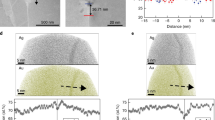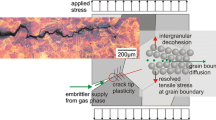Abstract
In this article, we examine the effect of aging treatment and the role of planarity of slip on stress corrosion cracking (SCC) behavior in precipitation-hardened alloys. With aging, the slip mode can change from a planar slip in the underage (UA) to a wavy slip in the overage (OA) region. This, in turn, results in sharpening the crack tip in the UA compared to blunting in the OA condition. We propose that the planar slip enhances the stress concentration effects by making the alloys more susceptible to SCC. In addition, the planarity of slip enhances plateau velocities, reduces thresholds for SCC, and reduces component life. We show that the effect of slip planarity is somewhat similar to the effects of mechanically induced stress concentrations such as due to the presence of sharp notches. Aging treatment also causes variations in the matrix and grain boundary (GB) microstructures, along with typical mechanical and SCC properties. These properties include yield stress, work hardening rate, fracture toughness K IC , thresholds K Iscc, and steady-state plateau velocity (da/dt). The SCC data for a wide range of ductile alloys including 7050, 7075, 5083, 5456 Al, MAR M steels, and solid solution copper-base alloys are collected from the literature. Our assertion is that slip mode and the resulting stress concentration are important factors in SCC behavior. This is further supported by similar observations in many other systems including some steels, Al alloys, and Cu alloys.













Similar content being viewed by others
References
D.O. Sprowls and R.H. Brown: Fundamental Aspects of Stress Corrosion Cracking, NACE, Houston, TX, 1969, pp. 466–512.
M.O. Speidel and M.V. Hyatt: Advances in Corrosion Science and Technology, Plenum Press, New York, NY, 1972, vol. 2, pp. 115–335.
N.J.H. Holroyd: EICM Proc., NACE-10, NACE, Houston, TX, 1971, pp. 311–45.
N.J.H. Holroyd, L. Christodoulou, and A.K. Vasudevan: in Aluminum and Its Applications, A.K. Vasudevan and R.D. Doherty, eds., Academic Press, New York, NY, 1987, pp. 463–81.
ASM Handbook, vol. 13A, Corrosion: Fundamentals, Testing and Protection, ASM INTERNATIONAL, Materials Park, OH, 2003.
A.K. Vasudevan and R.D. Doherty: Treatise Mater. Res. Technol., Academic Press, New York, NY, 1989, vol. 31.
R.P. Wei: in Hydrogen Effects in Metals, I.M. Bernstein and A.W. Thompson, eds., TMS, Warrendale, PA 1981, pp. 677–89.
R.P. Gangloff: in Compressive Structural Integrity, I. Milne, R.O. Ritchie, and B. Karihaloo, eds., Elsevier, New York, NY, 2003, pp. 1–194.
R.H. Jones: Stress Corrosion Cracking, ASM INTERNATIONAL, Metals Park, OH, 1992.
F.S. Bovard: Master’s Thesis, University of Pittsburgh, Pittsburgh, PA, 2005.
L. Young: Ph.D. Thesis, University of Virginia, Charleston, VA, 1999.
D.P. Dautovich and S. Floreen: Stress Corrosion and Hydrogen Embrittlement in Iron Base Alloys, NACE-5, NACE, Houston, TX, 1973, pp. 798–815.
C.S. Carter: Metall. Trans., 1970, vol. 1, pp. 1551–59.
C.S. Carter: Metall. Trans., 1971, vol. 2, pp. 1621–26.
R. Goswami: NRL Laboratory Data, NRL Laboratory, Washington, DC, unpublished research, 2009.
R.H. Jones, D.R. Baer, M.J. Danielson, J.S. Vetrano, and C.F. Windisch, Jr.: in Chemistry and Electrochemistry of Stress Corrosion Cracking: A Symp. Honoring the Contribution of R.W. Staehle, R.H. Jones, ed., TMS, Warrendale, PA, 2001, pp. 583–94.
R.H. Jones, D.R. Baer, M.J. Danielson, and J.S. Vetrano: Metall. Mater. Trans. A, 2001, vol. 32A, pp. 1699–711.
D.O. Sprowls, M.B. Shumaker, J.D. Walsh, and J.W. Coursen: “Final Report Part I: Evaluation of SCC Susceptibility Using Fracture Mechanics Techniques,” Contract NAS 8-21487, G.C. Marshall Space Center, Huntsville, AL, May 31, 1973.
F.S. Bovard: in Corrosion in Marine and Saltwater Environments II, Electrochemical Society Proc., D.A. Shifler, T. Tsuru, P.M. Natishan, and S. Ito, eds., Electrochemical Society, Pennington, NJ, 2005, vol. 2004-14, pp. 232–43.
D.J. Quesnel, Y. Zhang, and Q. Wan: Metall. Mater. Trans. A, in press.
M.O. Speidel: Metall. Trans. A, 1975, vol. 6A, pp. 631–50.
P.K. Poulose, J.E. Morall, and A.J. McEvily: Metall. Trans., 1974, vol. 5, pp. 1393–400.
J.K. Park and A.J. Ardell: Metall. Trans. A, 1984, vol. 15A, pp. 1531–43.
J.K. Park: Mater. Sci. Eng., 1988, vol. A103, pp. 223–31.
T. Ashai, F. Yabusaki, K. Osamura, and Y. Murakami: Proc. 6th Int. Conf. on Light Metals, Leoben, Vienna, 1975, pp. 64–67.
G.M. Scamans: Scripta Metall., 1979, vol. 13, pp. 245–50.
P.R. Swann: Corrosion, 1963, vol. 19, pp. 102–12.
P.R. Swann and J.D. Embury: High Strength Materials, Wiley, New York, NY, 1965, pp. 327–62.
C. Edelneanu: JISI, 1953, vol. 175, pp. 390–92.
D.I. Douglas, G. Thomas, and W.R. Roser: Corrosion, 1964, vol. 20, pp. 54–61.
Metals Handbook, 9th ed., ASM, Metals Park, OH, 1986, vol. 11, p. 221.
G. Edmunds: Symp. on Stress Corrosion Cracking of Metals, ASTM-AIME, 1945, pp. 67–89.
E.N. Pugh, J.V. Craig, and A.J. Sedriks: Proc. Fundamentals of Stress Corrosion Cracking, NACE, Houston, TX, 1969, pp. 118–58.
A.J. McEvily and A.P. Bond: J. Electrochem. Soc., 1965, vol. 112, pp. 113–38.
W. Rostoker, J.M. McCaughey, and H. Markus: Embrittlement by Liquid Metals, Reinhold Publishing Co., New York, NY, 1960, ch. 5.
S. Lynch: Acta Metall., 1988, vol. 36 (10), pp. 2639–61.
Y. Horse and T. Mura: Eng. Fract. Mech., 1984, vol. 19, pp. 317–29.
M.C. Reboul, T. Magnin, and T.J. Warner: in Proc. 3rd Int. Conf. on Aluminum Alloys, Trondheim, Norway, L. Arnberg, O. Lohne, E. Nes, and N. Ryum, eds., 1992, pp. 453–60.
G.A. Young and J.R. Scully: Metall. Mater. Trans. A, 2002, vol. 33A, pp. 101–15.
S. Knight: Ph.D. Thesis, Monash Univ., Melbourne, Australia, 2008.
R.C. Newman and R.P.M. Proctor: Br. Corr. J., 1990, vol. 25 (4), pp. 259–69.
R.C. Newman: in Corrosion Mechanisms in Theory and Practice, P. Marcus and J. Oudar, eds., Marcel Dekker, Inc., New York, NY, 1995, pp. 311–72.
K. Sadananda and A.K. Vasudevan: Metall. Mater. Trans. A, DOI:10.1007/s11661-010-0472-3.
D. Kujawski and K. Sadananda: Metall. Mater. Trans. A, DOI:10.1007/s11661-010-0373-5.
T.P. Hoar: 2nd Int. Congr. on Metallic Corrosion, NACE, Houston, TX, 1953, pp. 14–22.
L. Graf: 2nd Int. Congr. on Metallic Corrosion, NACE, Houston, TX, 1953, pp. 89–97.
Acknowledgments
The authors thank Professor Kujawski, Western Michigan University, for critically reading the manuscript, and Dr. Goswami, NRL Laboratory, for parting with the TEM and SEM of his work. The majority of the literature data was collected at the NRL/NIST libraries over a period of 10 years by both authors. The analysis was done with ONR-ROPO (AKV). KS acknowledges the support received from TDA and the U.S. Navy (NAVAIR) under Contract No. N00421-09-C-0002.
Author information
Authors and Affiliations
Corresponding author
Additional information
Manuscript submitted: February 12, 2010
Rights and permissions
About this article
Cite this article
Vasudevan, A.K., Sadananda, K. Role of Slip Mode on Stress Corrosion Cracking Behavior. Metall Mater Trans A 42, 405–414 (2011). https://doi.org/10.1007/s11661-010-0471-4
Published:
Issue Date:
DOI: https://doi.org/10.1007/s11661-010-0471-4




